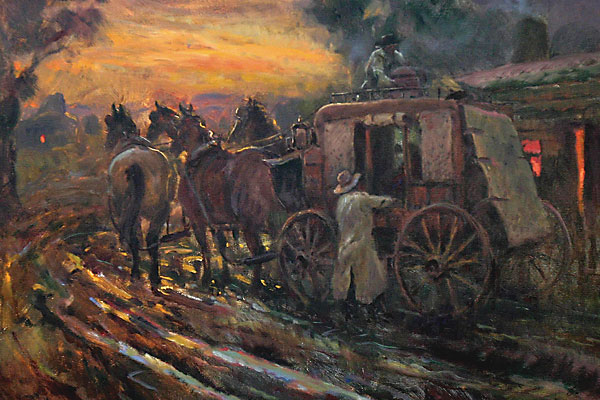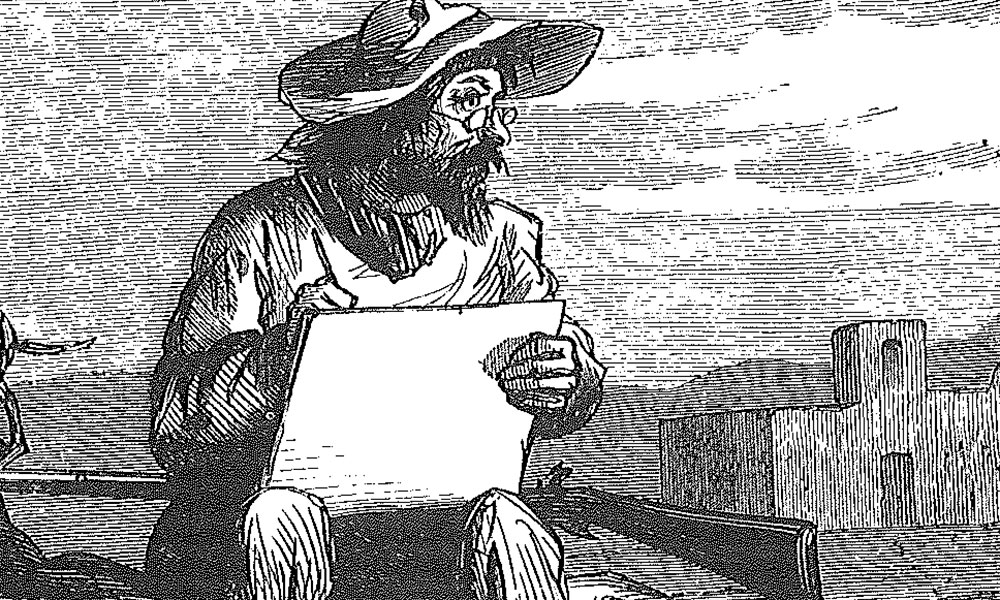
A quintessential “pull yourself up by your bootstraps” innovator who had little formal education and was himself a mere stagecoach driver would go on to lead the charge of our nation’s first transcontinental stage line 150 years ago.
His new way of travel in the southwest took people, correspondence and freight in a short time from the populated areas along the Mississippi River to the West Coast.
In 1857, the need for an overland mail route that serviced the West caused Congress to pass the Post Office Appropriations Bill. Nine bids were considered and on September 15, 56-year-old John Butterfield Sr. of the John Butterfield Company was awarded the winning bid for six years, not to exceed $600,000. Butterfield had started off as a stagecoach driver for Thorp and Sprague of Albany, New York, but by 1830, he set up his own business with one horse and a two-seated carriage. He must have done well, as he expanded into the lake steamer trade and convinced Henry Wells and William Fargo to merge their express companies with his to become the American Express Company.
The government contract Butterfield got required trips to the West Coast twice a week, each within 25 days, and claimed the option to change the route. He had originally wanted to travel the Santa Fe Trail into New Mexico and then to California along the 35th degree parallel. But the Southern postmaster general required that the route be similar to James Birch’s, which carried mail and passengers from San Antonio, Texas, to San Diego, California. This route added 600 miles and required extra relay stations to be built—a disadvantage, since the winner had one year from the time of the approval to be up and running.
All nine bids had St. Louis as their starting point, but went different paths after that. St. Louis, at the time, had 12 railroads and 70 steamships that stopped there, a natural choice. Butterfield chose the southernmost route because of the availability of water and fewer geographical problems. This route began at Tipton, Missouri, 150 miles west of St. Louis, and continued to Fort Smith, Arkansas, to Franklin, Texas (now El Paso), on to Arizona City (now Yuma, Arizona), Los Angeles, California, and terminated in Yerba Buena (San Francisco). Butterfield did not propose one of the northern routes as winter snow shut down parts of the line for months. The Mormon War was also going on and having a southern route put the stages away from any possible fighting. Butterfield’s southern route grew out of an 1854 survey Cap. John Pope conducted for the War Department, which was seeking a Mississippi River-to-Pacific Ocean railroad route and generally followed Randolph Marcy’s 1849 trail across Texas.
Not to be confused with the Butterfield stage that ran into Denver, Colorado, or smaller sections that are found east of the Mississippi, the Butterfield Overland Stage ran nonstop from 1858-1861 and was approximately 2,800 miles long. The highest bidder didn’t just earn the right to transport mail but he could also carry passengers and freight. The winning company could also preempt 320 acres at each station, if they were farther than 10 miles from each other unless the land was already encumbered or set aside for minerals.
A year passed before Butterfield secured 140 relay stations, bought 1,800 head of stock, 250 Concord and Celerity coaches, hired 800 men, built bridges, removed large rocks from trails, dug wells and cleared passes through mountains. He also built corrals and repair shops, and placed horses and mules along the trail. Each station needed food for the employees and riders, along with 50 to 100 tons of hay and grain and sometimes water. He divided the route into sections and subsections, which made this operation easier. When possible, he set up established homes and ranches as stations, saving the company money. Preexisting ferries and natural fords were used as much as possible for the same reason.
Finally, on September 16, 1858, the first trip launched. Butterfield’s son drove the first leg and a reporter from The New York Herald named Waterman L. Ormsby went along. This first westbound stage arrived in San Francisco on October 10, ahead of schedule.
Tipton is where the mail/passenger line began. The mail was carried by the Pacific Railroad from St. Louis and then put on the stage to go west. The mail was carried semi weekly over the 2,750 miles of the trail through 61 stops from Tipton to El Paso and 79 from El Paso to San Francisco, crossing eight major rivers. The longest section was the 70 miles between Head of Concho to Horsehead Crossing at the Pecos River. The shortest was the first going west, Tipton to George Shackleford’s farm—seven miles.
Butterfield’s coaches sometimes “walked the rough hills,” but maintained an average of five to nine miles per hour. The coaches needed to run night and day to meet this deadline requested by the government. But the average trip took only 22 days instead of the contracted 25.
Each passenger could carry 40 pounds of baggage. A one-way ticket was $200 or 15 cents per mile if they did not want the complete trip (equivalent to roughly $3,000 today). First-class postage for a letter was three cents per half ounce; each stage carried an average of 170 pounds of letters and another 140 pounds of newspapers. Freight was $1 per 100 pounds per 100 miles.
One quarter of all the company’s employees were drivers. Each driver had a 60-mile section and carried a bugle to warn the station keeper when the stage was close. The company wanted a 10-minute turnaround at these stations. Known as “Knights of the Road,” the drivers were described by passengers as cautious, mostly friendly—and some just insane. Besides drivers, Butterfield also had in his employ blacksmiths, keepers (station masters) and conductors. Conductors rode with the driver and gave instructions to the riders. The keepers took care of the animals and fed the passengers. A typical meal was tea, bread and steaks of bacon, deer, antelope or mule. Closer to both ends of the route, riders could get vegetables, butter and milk to complement the basics.
Station masters, armed to the teeth with revolvers, bowie knives and a stand of rifles in their stations, were told to shoot only when lives of passengers were “endangered.” The stages also carried no gold or silver shipments to cut down on attacks by highwaymen.
The company faced little problems with the Indians. In fact, Cochise and his band had contracts to supply firewood for the Apache Pass station. The biggest problem, it seemed, was the loss of an estimated 1,500 hats each year by the passengers.
The Butterfield Trail was the longest stage ride in the world undertaken by one company. The inhabitants of California considered the stage line to be the most important event in their state’s history, next to the discovery of gold. Some European travelers opted to take this route, instead of the steamship’s route around South America. At times, passengers had to wait for days for a seat to be open. And it was always best to know and like your fellow passengers since you were going to spend a long time with them. Imagine the days and nights passengers spent bouncing around in a 42-inch seat, three people per side. They slept—or at least tried to sleep—while the rocking continued. One traveler noted that a fellow companion went crazy from lack of sleep; he was bound and tied in the “Boot,” and left at the next station until he recovered.
The operation was a success for the company and the riders, but not for the post office as it lost money on the endeavor every year. The information flowed outbound too, as newspapers in Fort Smith, Saint Louis, Memphis and San Francisco carried news of what went on at Concho Station, Fort Chadbourne, Phantom Hill, Belknap and Jacksboro.
When the Civil War began, the Wells Fargo Company, which had taken over Butterfield’s company, gained a monopoly over the long-distance overland stagecoach routes and mail service. Texas and Arkansas rebels confiscated many of the coaches and horses for the war effort. In 1869, the first transcontinental railroad was finished and the need for transcontinental passenger and mail travel by stagecoach was no more. For the short period of stagecoach travel, it was a great boon to the frontier families all along the route, bringing frequent and dependable mail and freight service, visitors and news of the rest of the world, both in newspapers and through the oral accounts of the passengers.
To us today, the 25-day trip seems slow, when you can fly from St. Louis to San Diego in less than five hours, except when you realize that just 15 years earlier, many were making the trip to California in two and a half or three months in their wagons. Back then, the guidebooks for the travelers were recommending that they carry $200-$300 worth of food and supplies for the trip plus the cost of their wagons and spare parts. Butterfield’s stage certainly was a money and time saver.






